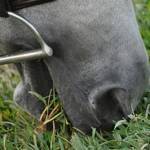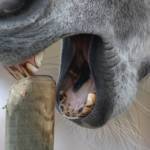Choosing a Horse’s Bit for Comfort and Effectiveness

Horse owners look for two basic things in a bit: comfort for the horse and control for the rider. However, the available variety of bit styles, sizes, actions, and materials is overwhelming, and choosing the right bit isn’t always easy, especially for a new rider.
Even with this incredible variety, selecting a bit may be simpler than you think. First, look at the bits being used by those who ride the same type of horse in the same discipline that you have chosen. Choosing a bit of the same type used by these more experienced riders is probably a good place to start. Avoid the extremes: most likely you don’t need a bit with super-long shanks or an excessively high port.
Thickness and width of the mouthpiece are important because in general, thicker mouthpieces cause less discomfort to the horse. Width should be about half an inch wider than the horse’s mouth to avoid pinching the jaw. You may be able to try out some bits owned by other people to help determine the correct width for your horse.
Ask more experienced riders to help you adjust the bridle so that the bit rests at the proper level in the horse’s mouth. It should not be so low that it bangs the horse’s teeth, or so high that it causes excessive wrinkling at the corners of the mouth.
Bits may be constructed of various metals, rubber, or plastic. For pleasure riding, just about any material may be acceptable, but some disciplines such as dressage have explicit requirements that cover bit construction, thickness, and form. A show official is stationed outside the show ring to check each horse’s bit, and anyone using a nonapproved bit is not allowed to ride. Be sure to check the rulebook for your discipline of choice as to the most recent bit regulations.
Stainless steel, cold-rolled steel, nickel, brass, silver, and copper are common bit materials, and many bits use a combination of metals to add durability or encourage salivation. Copper inlays are a popular choice to help keep the horse’s mouth moist. Bits that appear to be covered with a thin layer of rust are made of so-called “sweet iron” and the rusty flavor is said to be pleasant for horses.
A familiar scenario is a horse that doesn’t behave well in a certain bit. The rider’s fix for this situation is to get a different bit that produces a harsher action in the horse’s mouth. The horse, instead of performing better, gets jumpier and harder to ride, so the rider looks for an even more severe bit. The end of the story is often a nervous, unhappy horse and an owner who begins to find reasons to avoid riding.
Before starting down this path, consider other reasons why a horse might be fighting the bit or misbehaving under saddle. First, have a competent veterinarian or equine dentist examine the horse’s teeth. A broken molar, sharp point, or retained deciduous tooth may be to blame, or the current bit may have caused an injury or bruise to the horse’s mouth.
Second, the rider’s hands may be rough or overactive, causing the horse to try to evade bit pressure. Rather than choosing a more severe bit, going back to a thick snaffle can sometimes works wonders for these horses because this is a gentler bit that spreads the pressure over a wider area. However, any bit can cause pain if it’s used in the wrong way or if pressure is applied all the time. Combined with curb chains or other devices, some bits are capable of inflicting severe injuries on a horse’s jaw and palate. Instead of pulling harder on the reins, try letting out about half an inch of rein at a time and see whether the horse goes more quietly. Use gentle pressure instead of jerking or tugging at the reins, and never take out your anger on the horse by deliberately causing painful bit action.
Finally, the rider may have quiet hands but just not enough riding knowledge, and the horse may be getting contradictory signals from the rider’s hands, legs, and weight. This is even more of a problem if the horse is also young or untrained. Ask a more experienced rider to get on the horse and see if it seems to go better for this person. If so, you may be able to find an instructor who can help you learn to communicate better with your mount.
For some horses, a bit of any type seems to be an aggravation that makes it impossible for the horse to relax and offer a quiet ride. Getting rid of the bit and riding in a bitless bridle or a hackamore may be the only way to overcome this problem. These appliances may look gimmicky, but a fair number of top competition horses regularly compete and win with these systems.








